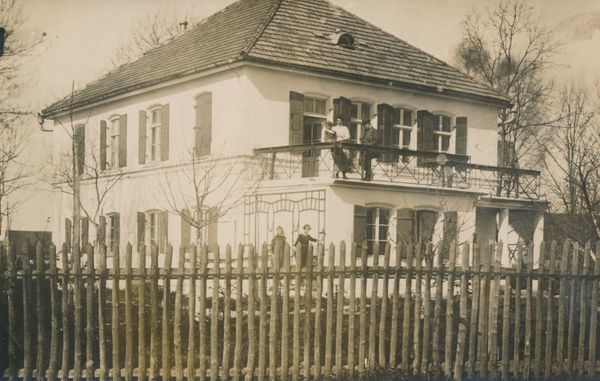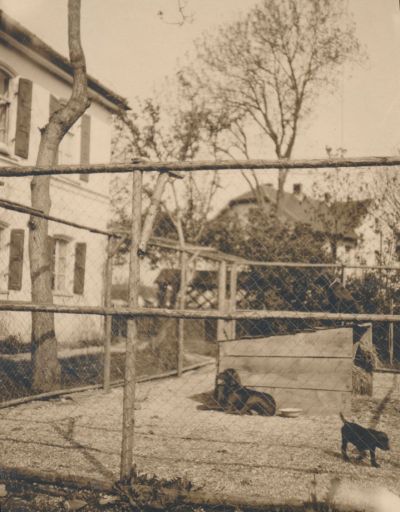The Eckart Family in Poing, Germany
The Old Schoolhouse in Poing
Several things connected the families of Otto and Fritz Eckart to the municipality of Poing. The two brothers, both passionate hunters, had taken a lease on the hunting grounds in Poing and Grub. Their father Johannes Eckart’s former estate, which supplied the canning factory "Johs. Eckart Konservenfabrik" with farm produce, was in Grub near Poing. While walking through Poing in the summer of 1910, Otto and Anita discovered an old, vacant house. There was an old pumping well in the garden, two chestnut trees in front of the house, a few ash trees in the west, and the south-facing side of the house was overgrown with a wildly growing real grapevine. This spacious house no. 40 was the former schoolhouse of Poing. It had been built in 1873 by master builder Johann Baptist Haydn. A new one was built in 1908 as the number of pupils had tripled over the decades and the house had become too small. The old schoolhouse remained vacant for two years.
That summer, in 1910, Anita and Otto Eckart rented the house as summer residence for a monthly rent of ten Deutsche Mark; on October 3, 1910, the couple bought the house. The money for buying and then renovating the house came from Adolf Hoppe, Anita Eckart’s father. Considerable work had to be done before the young family was able to move in: walls were replaced, a room with balcony and veranda was added, a cellar was dug out, a new front door with porch was built, damaged brickwork was repaired and the whole house was thoroughly renovated. The next challenge was the garden: the grapevine had died during the reconstruction, so two apple trees and a cherry tree were planted at the south-facing side to replace it. Otto had a small hill constructed close to the fence of the property, using building rubble and excavated earth from the cellar; an alpine garden and a small log cabin were soon erected on this hill, the so-called "coffee hill". The reconstruction measures took some time, but the family was able to move into the house on April 1, 1911.
Residence and Central Reference Point in Poing
The actual house-warming party took place at Pentecost (Whitsunday) in 1911. At this point, if not before, it was becoming clear that Poing would soon be an important reference point; not only for the family, but also for friends and acquaintances. Many guests came and were happy to stay the night, and sometimes even stayed with the family of Anita and Otto Eckart at the estate in Poing for several weeks. Along with two girls who helped Anita with the household, the family employed a servant who was also the gardener. On November 4, 1911, Otto bought the neighboring property so as to extend the garden to the east. In 1912, he was able to resell part of the new property, including an old, dilapidated house. Furthermore, the family exchanged 0.044 ha of the newly acquired property for 0.038 ha of a property called "Franzosenbreite" (literally translated: breadth of the French) with their neighbor Gerbl.
Otto started to breed dogs, and this was soon followed by pigeons. Between six and 16 dogs always lived in the large spacious dog kennel. A room in the attic was converted into a loft for carrier pigeons. Pigeon races were often held for the guests and bets could be placed. The Eckart family received many prizes for their pigeons, among them the Silver State Medal of Bavaria. During World War I, the carrier pigeons were confiscated as trained military pigeons. What is more, they were no longer allowed to fly out, but had to be kept in the loft.
The family lived in Poing for three years. In October 1914, the family rented an apartment again in Munich. The firstborn daughter Ruth had reached compulsory school age and was supposed to go to school in Munich. The distance was too far to commute every day. From that time on, the estate in Poing was only supposed to be used as the family’s summer residence. The family continued to spend school and public holidays in Poing, including the Christmas of 1914.
The Eckart family spent most of World War I in Kiel in Northern Germany. They only moved back to Poing at the end of the war and this is where they stayed during the time of the Munich Soviet Republic. At that time, officers of a Freikorps (paramilitary unit) that murdered people in Munich were accommodated at the estate in Poing.
The New Farm Building
Between 1915 and 1919, the estate in Poing was extended by five hectares, which included fields and meadows as well as the neighboring house no. 35, the so-called Laurent house. Otto and Anita had Laurent house demolished in 1919; master builder Lanzl built a new farm building for a total of 100,000 Deutsche Mark according to plans by the architect Max Roth. It was in this building that three rooms and a kitchen-cum-living room on the first floor were furnished for the gardener and his family, while three rooms and a kitchen-cum-living room on the second floor were furnished as a guest apartment. The first guest was Alfons Hoppe, Anita’s father, who had provided financial support to the family again, funding all the furnishings for the guest house.
The farm at and around the estate in Poing grew steadily. In 1932, there were 18 Tagwerk of land (an old German surface measure; one Tagwerk corresponds to approximately 3,408 m2), the female donkey Mina von Barnhelm, three to four cows, two horses and several pigs as well as poultry. In the aftermath of the war, Otto Eckart’s family had taken residence again in Munich. In Poing, it was mainly the gardener and his family residing in the farm building who took care of the Eckarts’ agriculture. When the gardener resigned in 1932 in order to establish his own farm, Anita and Otto decided to abandon their agricultural holding. The meadows and fields were rented out, the livestock and the deadstock were sold. That same year, the couple also decided to rent out the house no. 40 in the future, now a magnificent villa. This decision was triggered by the fact that the house had been burgled twice during the family’s long absences, though much effort was required to maintain the villa. Otto Eckart’s family continued to come to Poing in the summer and during the public holidays, from then on staying in the guest apartment on the second floor of the farm building.
Members of the Eckart family only lived permanently at the estate in Poing again in late summer of 1939. Ruth, the eldest daughter of Otto and Anita, moved from Berlin to Poing with her three children on September 17, 1939. Her husband, Fritz Reuter, had to stay in Berlin for work. Ruth also started to keep livestock again for food supply during the war. Eventually, the other family members returned to Poing in 1944 due to the bombing of Munich: Aunt Hedwig and Inge, Werner and Anny with their children Otto, Heidi, and Gisela. Time and again, companies of soldiers were also accommodated at the estate in Poing during the war.
Following the deaths of Otto and Anita, the estate in Poing came into the possession of Ruth Eckart and her husband Fritz Reuter, who died here in 1971. Ruth’s son Klaus Reuter built a house in the park next to the villa in the 1960s; this is where he lived with his wife Marianne and his sons Wolfgang, Thomas, and Stefan and where he also had his general practitioner’s surgery. The farm building located in the street Anzinger Strasse was sold to the neighbor and demolished; an apartment house was built on this plot around the year 2000. The park was made smaller and sold to the municipality under the name “Reuterpark”. Around 2016/17, Marianne Reuter sold her last property, the old villa.
Sources
- Eckart Family Archive, Book of recollections from Poing, 1969.
- Conversation with the contemporary witness Heidi Killinger, January 21, 2020.


